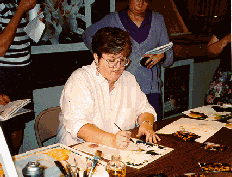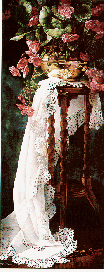|
"An artist cannot fail. It is a success to be one." Charles Horton Cooley
Arleta Pech
© 2000 Nita Leland
Arleta and I met when we were both teaching seminars in Monterey, California in 1998. I was immediately drawn to her sense of humor and down-to-earth nature and totally amazed at her sparkling, detailed floral and still-life watercolors.
|
Q. Arleta, what inspired you to begin painting?
A. It started as a hobby as a child. My mother kept me supplied with paint, pencils, books, even paint-by-number kits. I didn't take art in school. When my husband saw my early artwork, he wondered why I didn't paint anymore. I said I didn't have paints, and the next day he bought me a set of acrylics. At first I worked in oil and acrylic, but when I tried watercolor in 1973, I knew I had found my medium. Now I work exclusively in watercolor.
|
 |
Q. How have you developed your skill?
A. Mainly from books, as there was little money for classes. I really loved my watercolor books. I would get a bit of information from this one and that. I think that's why my style is my own. No one teacher's method or techniques influenced me. I advise artists to paint every day so your preferences will emerge and your style develop. As an instructor I see students who continually take classes are afraid to trust what they know. |
 |
Q. Do you paint every day? For how long? How long does it take you to do one of your intricate watercolors?
A. I paint almost every day. The business part of my career takes up some days. Last year I traveled 15 weeks teaching. A detailed painting can take three or four months from inspiration to finish. A simple floral can be a few weeks. If I'm having trouble, it can be a year, since I put it away and bring it out off and on till it's finished.
Q. Have you always preferred still life and flowers? Do you ever paint landscapes or portraits?
A. I've painted just about every subject, especially when I was learning. Florals have been my passion since the early 80s. Still lifes were an extension of the floral, and my fascination with lace came from my grandmother, who taught me to crochet. I realized early on that to become nationally known, you need a recognizable style and subject. |
 |
Q. What brought about your beautiful, informative book?
A. Painting Fresh Florals in Watercolor followed my article in The Artist's Magazine in 1995. The response to the article was so good that North Light Books contacted me. I decided to do it to help get into teaching more workshops. It was one of the best things I've done since Mill Pond Press, the two highlights of my career as an artist. |
Q. Tell us about your association with Mill Pond Press.
A. Mill Pond was my publisher of limited edition fine art prints for several years. I was showing my work in local galleries and when they saw my work they asked to represent me. My florals became internationally known practically overnight. Pretty heady stuff! They were my publishers and agents from 1989 t 2001. My images received exposure to collectors world wide and were licensed to appear on gift items. It's not all a bed of roses. There's a lot of competition and not every painting gets reproduced. The up-side is it has gained me exposure and recognition I couldn't have achieved on my own. Now I'm with another reputable publishing company, Hadley House.
Q. Do you enter juried shows very often? Why or why not?
A. At first I entered competitions and got lots of rejections, but I achieved signature membership in the Rocky Mountain National with five acceptances. It's nice to have that acceptance, but I soon learned that I would rather sell paintings to support my family than do competition pieces.
Q. What are your goals for your students?
A. Observe, Understand, Practice and Apply. I give my students manageable projects so they come away with a positive learning experience.
Q. You've also done your own Web site. How did you manage that? Any advice for artists about this?
A. I did my own Web site and I'm no computer expert. I used Microsoft Publisher, which was simple and fun. It's good exposure for me to potential students and galleries. If an artist wants to make a Web page or site, you need to know what you want it to accomplish. And you still have to advertise so people will know where to look for you.
Thanks to Arleta Pech for a delightful interview. You can email Arleta at
arleta@arletapech.com. Be sure to visit Arleta's Web site.
|



